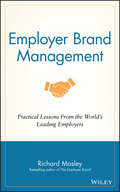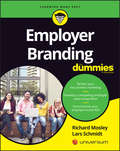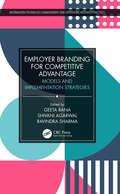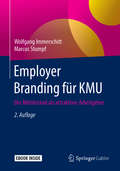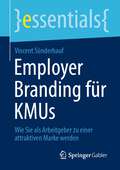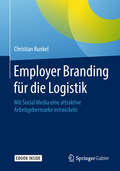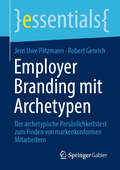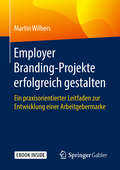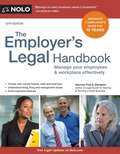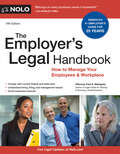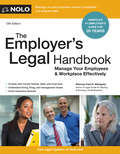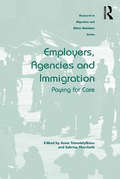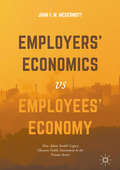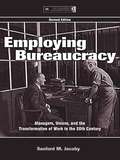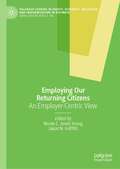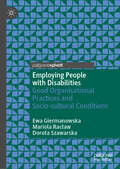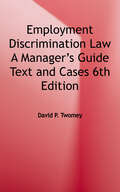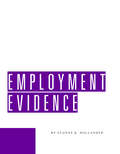- Table View
- List View
Employer Brand Management
by Richard MosleyAttract, recruit, and retain the very best with a strategicemployer brand From one of the world's leading pioneers in the employer branddiscipline and author of the first book on the subject TheEmployer Brand, comes the long-awaited practical follow-upEmployer Brand Management. Talented, motivated employees area company's best assets, and the techniques in this book helpattract, recruit, and retain the very best. A successful employerbrand reaches beyond the boardroom to establish confidence,loyalty, and enthusiasm all the way down the ladder. EmployerBrand Management gives readers a personal grasp of a newapproach to people management. It draws on significant advances inpractices among leading companies to provide a handbook foremployer brand development and implementation. With a wide range ofcase studies and examples, you'll be taken step-by-step through theemployer brand development process. You will find information onthe latest developments in technology, with particular attentionpaid to socially-enabled recruitment marketing and employeecommunication and engagement.You will:Follow the process of brand planning, definition,implementation, and applicationDiscover how brand thinking can strengthen strategy andreinforce HR valueImprove existing recruitment and talent managementprogramsLearn the importance of employee engagement in the brandexperience
Employer Branding For Dummies
by Richard Mosley Lars SchmidtAttract the very best talent with a compelling employer brand Employer Branding For Dummies is the clear, no-nonsense guide to recruiting and retaining top talent. Written by the head talent warrior at Universum, this book gives you the hard facts and expert insight you need to build your brand as a great place to work. You'll learn how to research what makes your company stand out, the best ways to find the people you need, and how to convince those people that your company is the ideal place to exercise and develop their skills. The discussion includes ways to identify the specific traits that spell success at your company, and how to translate those traits into hiring metrics that only let the good ones through. You'll build and maintain your own distinctive, credible employer brand, and develop a set of relevant, informative Key Performance Indicators to help you keep the ball rolling. For most people, work is more than what they do — it's a part of who they are. This guide shows you how to discover and develop your employer brand to draw the quality talent you need. Create a distinctive employer identity Perfect your talent sourcing techniques Track the right Key Performance Indicators Recruit and retain the very best talent Face it: the very best employees are the ones with the most options. Why should they choose your company? A strong employer brand makes the decision a no-brainer. It's good for engagement, good for retention, and good for the bottom line. Employer Branding For Dummies helps you hone in on your unique, compelling brand, and get the people you need today.
Employer Branding for Competitive Advantage: Models and Implementation Strategies (ISSN)
by Shivani Agarwal Geeta Rana Ravindra SharmaThis book shows how to build and maintain a distinctive and credible employer brand and develop a set of relevant success metrics to help measure return on investment (ROI). Starting with the current interest in employer branding, this book looks at the historical roots of brand management and the practical steps to achieve employer brand management success.The book will review the pressures that have generated current interest in employer branding. It goes on to look at the historical roots of brand management and the practical steps necessary to achieve employer brand management success. The book includes the business case, research, positioning, implementation, management and measurement, and case studies of big-named employer brand stories.This book will provide new insights into the field of employer branding and provide directions and tools for organizational brand building. It will be beneficial for research scholars, engineers, practitioners, and management students.
Employer Branding für KMU
by Wolfgang Immerschitt Marcus StumpfEine attraktive Arbeitgebermarke ist in Zeiten des Fachkräftemangels das A und O im Personalmarketing. Gerade für kleine und mittelständische Unternehmen im internationalen Konkurrenzumfeld stellt die Rekrutierung und Bindung geeigneter Mitarbeiter eine besondere Herausforderung dar. Dieses Buch zeigt strukturiert auf, wie KMU erfolgreiche Arbeitgebermarken schaffen können, und bietet fundierte Grundlagen, zahlreiche Praxisbeispiele und 22 anschauliche Unternehmensfallstudien. Die 2. Auflage wurde umfassend überarbeitet und um aktuelle Fallbeispiele ergänzt. „Die vorliegende Publikation zeichnet sich dadurch aus, dass nicht nur eine theoretische Fundierung erfolgt, sondern anhand zahlreicher Praxisbeispiele und Fallstudien der Umsetzungsprozess und das Controlling des Employer Branding speziell für den Mittelstand sehr praxisnah dargestellt wird.“ Univ.-Professor Dr. Dr. habil. Wolfgang Becker, Direktor des Europäischen Kompetenzzentrums für Angewandte Mittelstandsforschung, Otto-Friedrich-Universität Bamberg „Wie sich KMU als attraktive Arbeitgeber profilieren, ohne dabei die budgetären Möglichkeiten zu überspannen, zeigt das vorliegende Buch anhand einer Vielzahl von Praxisbeispielen. Es regt nicht nur zum Nachdenken über Rekrutierung und Mitarbeiterbindung an, sondern bietet ganz konkrete Handlungshilfen." Mario Ohoven, Präsident des BVMW – Bundesverband mittelständische Wirtschaft, Unternehmerverband Deutschlands e.V.
Employer Branding für KMUs: Wie Sie als Arbeitgeber zu einer attraktiven Marke werden (essentials)
by Vincent SünderhaufDieses essential erklärt, wie Employer Branding funktioniert und wie insbesondere kleine und mittelständische Unternehmen ihren Weg zu einer erfolgreichen Arbeitgebermarke finden können. Denn in vielen Branchen sind Fachkräfte und Spezialisten hart umkämpft, doch genau von diesen Experten hängt oft der Erfolg der unternehmerischen Entwicklung ab. Firmen, die sich mitten im Kampf um qualifizierte Arbeitskräfte befinden, müssen es also schaffen, aus der konkurrierenden Menge hervorzustechen und im War for Talents wirkungsvoll zu agieren. Insbesondere für mittelständische Unternehmen gibt es viele Chancen, ihre Arbeitgebermarke zu stärken und sich auf dem Markt begehrt zu machen – kompakte Tipps und Empfehlungen dazu bietet dieses essential.
Employer Branding für die Logistik: Mit Social Media eine attraktive Arbeitgebermarke entwickeln
by Christian RunkelDieses Buch vermittelt praxisnah am Beispiel der Logistik Branche, wie Unternehmen die Attraktivität ihrer Arbeitgebermarke mit einer Social-Media-Strategie langfristig steigern können, um dem Fachkräftemangel dauerhaft entgegenzuwirken. Denn ohne eine zielgruppenorientierte Kommunikation der eigenen Employer Brand kann Recruiting in der heutigen Zeit kaum gewährleistet werden.Auf Basis praxisbewährter Beratungskonzepte stellt der Autor zunächst die Grundlagen von Employer-Branding-Projekten vor, beschreibt Lösungsansätze und zeigt zusätzlich drei Fehler auf, die man bei Employer-Branding-Projekten begehen kann. Da insbesondere Social-Media-Kanäle helfen können, eine positive Wahrnehmung als Arbeitgeber zu etablieren sowie die Bekanntheit zu steigern, werden die wichtigsten Social-Media-Plattformen thematisiert.
Employer Branding mit Archetypen: Der archetypische Persönlichkeitstest zum Finden von markenkonformen Mitarbeitern (essentials)
by Jens Uwe Pätzmann Robert GenrichPersönlichkeitstests sind im Kontext der Personaldiagnostik und -entwicklung gut erforscht und in der Praxis eingesetzt, jedoch beschäftigen sich bisher wenige Autoren mit dem konkreten Einsatz von Persönlichkeitstests für ein zielgerichtetes Employer Branding.In diesem essential finden Sie einen neu entwickelten archetypischen Persönlichkeitstest, mit dem potenzielle Mitarbeiter auf Markenkonformität und bestehende Mitarbeiter auf Markenbotschaftereignung getestet werden können.
Employer Branding mit sozialer Nachhaltigkeit: Anforderungen aus Arbeitnehmersicht und deren Einfluss auf die Arbeitgeberattraktivität (essentials)
by Markus H. Dahm Annika DrägerDieses Buch zeigt, welche Anforderungen an soziale Nachhaltigkeit Arbeitnehmer haben, welchen Einfluss sie auf die Arbeitgeberattraktivität nehmen und wie Unternehmen diese Anforderungen erfüllen sowie für das Employer Branding nutzen können, um sich als attraktiver Arbeitsgeber zu positionieren. Denn Nachhaltigkeit weist eine zunehmend hohe Relevanz innerhalb der Gesellschaft auf, wodurch Arbeitnehmer neue Anforderungen an ihre Arbeitgeber definieren. Ein durch den Fachkräftemangel verknapptes Angebot an Personal veranlasst Unternehmen dazu, die Bedürfnisse der Mitarbeiter noch besser kennenzulernen und auf diese einzugehen.
Employer Branding-Projekte erfolgreich gestalten: Ein Praxisorientierter Leitfaden Zur Entwicklung Einer Arbeitgebermarke
by Martin WilbersHervorragende Arbeitgeber werden nicht in Werbeagenturen geboren. Die Überwindung des zunehmenden Fachkräftemangels braucht den Mut zur Veränderung und die innerliche Überzeugung der Geschäftsführung.Dazu gehört, sich konsequent mit dem eigenen Arbeitgeberangebot auseinanderzusetzen, zukünftige Zielgruppen zu analysieren und zielführend mit und an der eigenen Belegschaft zu arbeiten. Ebenso wie bei Produkt- und Unternehmensmarken, braucht „Employer Branding“ echte, zielgruppenorientierte Inhalte, erlebbares Verhalten und einen langen Atem.Welche Schritte Unternehmen gehen können, um die Loyalität von Mitarbeitenden zu festigen, Fehlzeiten zu verringern, die Leistungsbereitschaft zu steigern und Eindruck auf die Arbeitskräfte der Zukunft zu machen, zeigt dieses Buch im Überblick.
Employer Engagement: Making Active Labour Market Policies Work
by Jo Ingold and Patrick McGurkActive labour market policies aim to assist people not in work to move into employment through a range of interventions including job search, preparation, training and in-work support and development. While policies, programmes and scholarship predominantly focus on jobseekers’ engagement with these initiatives, this book is the first text to shed light on the employer’s perspective. Bringing together renowned scholars from social and public policy and human resource management, the book draws on empirical research, comparative case studies and real-life examples from practice, providing a comprehensive analysis of this under-explored issue. This go-to resource will inform HRM and public policy scholarship and promote collaborations between the disciplines.
Employer and Worker Collective Action
by Andrew G. Lawrence"This book compares sources of worker and employer power in Germany, South Africa, and the United States in order to identify the sources of comparative U. S. decline in union power and to more precisely analyze the nature of labor-movement power. It finds that this power is not confined to allied parties, union confederations, or strikes, but rather consists of the capacity to autonomously translate power from one context to the next. By combining their product, labor market, and labor law advantages through their dominant employers' associations, leading firms are able to impose constraints on labor's free collective bargaining regionally and nationally, defeating employer interests that are more amenable to labor in the process. Through an examination of these patterns of interest organization, the book shows, however, that initial employer advantages prove to be contingent and unstable and that employers are forced to cede to more far-reaching demands of increasingly organized workers"--
Employer's Legal Handbook, The
by Fred S. SteingoldNew laws affect every aspect of being an employer from interviewing and hiring to handling employee benefits and firings. The Employer's Legal Handbook is the most complete guide to your legal rights and responsibilities as an employer. This essential guide shows you how to comply with the most recent workplace laws and regulations, run a safe and fair workplace, and avoid lawsuits. Learn everything you need to know about: . Hiring: Understand the legal guidelines for hiring employees, writing job descriptions, conducting interviews and investigating applicants. . Smart personnel practices: What to include in employee personnel files, employee handbooks, performance reviews and references for former employees. . Wages & hours: Comply with federal and state overtime and minimum wage requirements. . Employee benefits: Learn the ins and outs of wage and hour laws, retirement plans and health insurance. . Workplace health and safety: Comply with OSHA requirements, and implement policies on smoking, drugs and alcohol abuse. . Discrimination: Prevent sexual harassment and discrimination based on age, race, pregnancy, sexual orientation and national origin. . Termination and layoffs: Avoid wrongful termination cases, conduct a final meeting and protect your business information when employees leave. . Laws affecting small business practices: Everything you need to know about the Americans With Disabilities Act, the Family and Medical Leave Act, health and safety issues, employee testing and more. This edition has been completely updated to reflect the most recent changes to the law, including information on healthcare reform, changes to the FMLA, laws that address social media and much more.
Employer's Legal Handbook, The: How to Manage Your Employees & Workplace
by Fred S. SteingoldHandle employment decisions legally and effectively—from hiring to firing Employment laws change often. Staying on top of them is essential to running an efficient, fair workplace—and heading off expensive lawsuits. Use this must-have desk reference to find answers to workplace questions, quickly and easily. The Employer’s Legal Handbook is the go-to guide for business owners and managers. It covers the most common and current employment law issues you need to know about, including: applications, interviews and hiring must-have personnel policies wage and hour laws employee discipline and performance reviews health care and other employee benefits employee taxes and payroll family and medical leave employee privacy illegal harassment and discrimination terminations, and downsizing and layoffs. This edition provides updated 50-state legal information and explains the latest developments in employment law, including monitoring of employee email and social media and employer drug policies in states that have legalized or decriminalized marijuana for medical or recreational use.
Employer's Legal Handbook, The: Manage Your Employees & Workplace Effectively
by Fred S. SteingoldAll the laws employers need to know! What do employers need to know about the law? Plenty! Employment laws change often. Staying on top of them is essential to running an efficient, fair workplace—and heading off expensive lawsuits. Use this comprehensive guide to find answers to workplace questions, quickly and easily. The Employer’s Legal Handbook covers all the employment law issues you need to know about, including the latest rules and best practices when it comes to: applications, interviews and hiring must-have personnel policies wage and hour laws employee discipline and performance reviews health care and other employee benefits employee taxes and payroll family and medical leave employee privacy illegal harassment and discrimination terminations, and downsizing and layoffs. The 13th edition provides updated 50-state legal information and explains the latest developments in employment law, including the effect of the Supreme Court’s same-sex marriage decision on employment matters.
Employer-Branding-Projekte erfolgreich gestalten: Ein praxisorientierter Leitfaden zur Entwicklung einer Arbeitgebermarke
by Martin WilbersHervorragende Arbeitgeber werden nicht in Werbeagenturen geboren. Die Überwindung des zunehmenden Fachkräftemangels braucht den Mut zur Veränderung und die innerliche Überzeugung der Geschäftsführung.Dazu gehört, sich konsequent mit dem eigenen Arbeitgeberangebot auseinanderzusetzen, zukünftige Zielgruppen zu analysieren und zielführend mit und an der eigenen Belegschaft zu arbeiten. Ebenso wie bei Produkt- und Unternehmensmarken, braucht Employer Branding echte, zielgruppenorientierte Inhalte, erlebbares Verhalten und einen langen Atem.Welche Schritte Unternehmen gehen können, um die Loyalität von Mitarbeitenden zu festigen, Fehlzeiten zu verringern, die Leistungsbereitschaft zu steigern und Eindruck auf die Arbeitskräfte der Zukunft zu machen, zeigt dieses Buch im Überblick.In der neuen Auflage wird ein Employer-Value-Proposition-Modell präsentiert. Dieses Modell bildet die wesentlichsten Einflussfaktoren auf die Arbeitgeberattraktivität einer Organisation ab und stellt das maßgebliche Fundament eines Employer-Branding-Projektes dar.
Employers, Agencies and Immigration: Paying for Care (Research In Migration And Ethnic Relations Ser.)
by Anna Triandafyllidou Sabrina MarchettiExploring the performance by immigrants of domestic and care work in European households, this book places the employer centre-stage, examining the role of the employer and his or her agents in securing the balance between work, family and welfare needs, as well as investigating both who the employers are and the nature of their relationships with migrant workers. With attention to the dynamics of inequality, as class, ethnicity and gender become intertwined in a location that is at once home and workplace, this volume is organised into sections that deal with the subjectivities of employers and their relationships with their employees in the home; the re-organisation of welfare and care arrangements at state level; and the wider area of migrant domestic and care work, with the transformation of the au pair scheme. Bringing together the latest empirical work from across Europe, Employers, Agencies and Immigration will appeal to social scientists with interests in migration, ethnic and class relations, immigrant labour and domestic work and the sociology of the family.
Employers’ Economics versus Employees’ Economy
by John F. M. McdermottThis book argues that economic activity in the public sphere now underwrites private corporations, and rejects rigid adherence to traditional economic theories that no longer apply. Adam Smith's widely used "merchant's model" assumes that most investment is private, when in fact research demonstrates that public investment in the workforce through education and training far outweighs the private sector, and does not account for the growing presence of consensual pricing, the diversification of modern businesses, or the increasing internal authoritarianism of globalizing companies. With de facto public support for these adaptations undermining the universally presumed economic model, private corporations are able to increase their profits while misrepresenting the investment of their own global labor forces. This book suggests an "economy of laws" solution that balances the needed degree of central investment planning with the continuation of our pluralist economy of largely autonomous firms, principally by extending the full rights of citizens into the workplace itself.
Employing Bureaucracy: Managers, Unions, and the Transformation of Work in the 20th Century, Revised Edition (Organization and Management Series)
by Sanford M. JacobyDeftly blending social and business history with economic analysis, Employing Bureaucracy shows how the American workplace shifted from a market-oriented system to a bureaucratic one over the course of the 20th century. Jacoby explains how an unstable, haphazard employment relationship evolved into one that was more enduring, equitable, and career-oriented. This revised edition presents a new analysis of recent efforts to re-establish a market orientation in the workplace. This book is a definitive history of the human resource management profession in the United States, showing its diverse roots in engineering, welfare work, and vocational guidance. It explores the recurring tension between the new professional order and traditional line management. Using a variety of sources, Jacoby analyzes the complex relations between personnel managers, labor unions, and government from the late 19th century to the present.Employing Bureaucracy:*analyzes the origins of the modern employment relationship's distinctive features;*combines a variety of disciplinary perspectives, from business and labor history to economics, sociology, and management;*shows the transformation of the American workplace over the course of the 20th century, from market-oriented to bureaucratic to recent efforts to move back to a market orientation; and*provides the single-best and most sophisticated history of the origins and development of the modern "HR" profession.For historians, social scientists, and practitioners, this book is a readable and rewarding study. With the future of work currently under debate, it is critical that the historical process that produced the modern American workplace is understood.Read the Workforce Management Magazine review about Employing Bureaucracy at www.erlbaum.com.
Employing Our Returning Citizens: An Employer-Centric View (Palgrave Studies in Equity, Diversity, Inclusion, and Indigenization in Business)
by Nicole C. Jones Young Jakari N. GriffithA criminal record can be a formidable employment barrier and is thus a major contributor to employment inequality, as most employers would rather avoid hiring an individual who has committed a crime. This book, offering an employer-centric view of the latest research findings, blends interdisciplinary theoretical perspectives and empirical findings to provide an overview and areas for future management research. The chapters assess the state of the field while highlighting the most critical themes that advance our understanding of the employment process and challenges for system-impacted individuals. Presenting a comprehensive assessment of the challenges and opportunities, this volume will appeal to disciplines related to organizational behavior, human resource management, and employment law, as well as any other disciplines that bear responsibility for enacting and crafting hiring and selection processes.
Employing People with Disabilities: Good Organisational Practices and Socio-cultural Conditions
by Ewa Giermanowska Mariola Racław Dorota SzawarskaDeveloping better employment and management practices for a diverse workplace is quickly becoming a major concern amongst most modern organisations; however, a lack of research into good practices has a limiting effect. Dealing specifically with disabilities, this pioneering work is based on international research spanning several European countries to demonstrate best practice. Aiming to fill a gap in knowledge, the authors offer interdisciplinary insights into managing diversity in the workplace, taking into account various social and cultural contexts. Providing analysis and recommendations for adapting organisational practices to different workplace settings, this Palgrave Pivot is a vital read for scholars of HRM and diversity management, as well as policy-makers and practitioners.
Employment Contracts and Well-Being Among European Workers (Contemporary Employment Relations)
by Nele De Cuyper Kerstin IsakssonTemporary employment contracts are now commonplace in business. However the move towards such employment structures has a significant, and hitherto little understood impact on 'the psychological contract' between employee and organizations. This book is amongst the first to tackle this problem. With detailed research findings from seven countries: Belgium, Germany, the Netherlands, Spain, Sweden, the UK and (for a non-European perspective) Israel, it presents an integrated model of the effects of temporary work. The model incorporates key recent trends, including the expansion of non-permanent employment as a persistent form of employment flexibility, the increasing importance of the psychological contract, and the diversity of the European labour market as a result of state legislation. By presenting the results of an overview of the research literature on this contemporary labour market trend this book is of real value to researchers, practitioners and policy makers.
Employment Discrimination Law: A Manager’s Guide Text and Cases
by David P. TwomeyA nationally known arbitrator in various employment-related disputes, Twomey offers insight from his on-the-job knowledge. This concise guide to employment discrimination and related laws raises awareness of issues in the workplace, enabling managers to provide the informed leadership necessary for a discrimination- and harassment-free working environment. <p><p>It includes updates on emerging employment and discrimination issues, such as Supreme Court rulings on sexual harassment and the ADA's narrowing scope of coverage. Employment Discrimination Law discusses factors important in determining when individuals are considered employees covered under the NLRA and when they are unprotected independent contractors. <p><p>Appendices offer excerpts from the EEOC's Guidance on Vicarious Employer Liability for Harassment by Supervisors and from the EEOC Guidance to Field Offices on ADA Charges.
Employment Effects of Growth Rebalancing in China
by Papa N'Diaye Kai GuoA report from the International Monetary Fund.
Employment Equity and Affirmative Action: An International Comparison (Issues In Work And Human Resources Ser.)
by Peter Sloane Frank Horwitz Harish C. JainThe authors of this comparative study of affirmative action compare the employment practices of six countries: the U.S., Canada, Great Britain/Northern Ireland, India, Malaysia, and South Africa. They look at mandatory quota policies; legislated versus voluntary policies; goals and timetables; restrictions and other policies; as well as recruitment, selection, compensation, performance appraisal, promotion, training, and career development. Their findings will prove useful for training managers of companies with global operations.
Employment Evidence
by Eugene HollanderEmployment Evidence This strategic guide to admission and exclusion gives you foundations, objections, responses, tactics, jury instructions, motions in limine, and supporting authority for all your evidence battles in employment cases. You'll get everything you need to win your battles over EEOC letters, unemployment records, arbitration decisions, past sexual conduct, after-acquired evidence, prior acts of disparate treatment, corrective action policies, disciplinary records, personnel files, defendant's net worth, plaintiffs' medical and psychological history and exams, undue hardship, BFOQs, and much more. Anticipate and circumvent problems in admitting your evidence and exclude/limit what the opposition throws at you. Designed for quick reference with centerfold index, tabbed dividers, shaded tips, boxed objections, argument checklists, tactics by part, and over 750 cases divided by admitting/excluding. In-depth treatment of rules, definitions and distinctions. Nearly every topic supported with multiple forms. This in-depth, easy-to-use, practical book will be indispensable in your employment cases.
